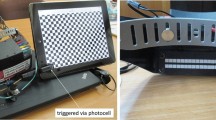Abstract
Purpose
To compare the modified signal-to-noise ratio (SNR*) of multifocal visual evoked potential (mfVEP) responses elicited by a cathode ray tube (CRT) and liquid crystal display (LCD) monitor in normal subjects.
Methods
An LCD monitor and CRT monitor were luminance and contrast matched. Luminance stability and the effect of viewing angle on luminance and contrast was measured for both screens. The SNR* of mfVEP responses from 15 normal subjects was compared between the stimulators using repeated measures analysis of variance.
Results
The CRT monitor took 10 min from switch on to reach the desired luminance compared to 60 min for the LCD monitor. LCD luminance was sensitive to variations in ambient temperature, fluctuating by 10 cd/m−2 over approximately 20–27 °C, whereas CRT luminance was stable. Luminance variation from the centre to the edge of the CRT screen was 8 % when viewed perpendicularly and 28 % when viewed at an angle of 25°, compared to 24 and 46 %, respectively, for the LCD screen. Contrast was >94 % and varied by <3 % across both monitors for both viewing conditions. There was no significant difference in SNR* between responses elicited by the two stimulators (p = 0.76).
Conclusions
CRT and LCD stimulators elicited mfVEP responses with similar SNR* in normal subjects. This study highlighted practical issues with the use of LCD monitors as visual stimulators, particularly with regard to warm-up time, luminance stability and luminance uniformity.








Similar content being viewed by others
Notes
\({\text{Contrast}} = \frac{{L_{\hbox{max} } - L_{\hbox{min} } }}{{L_{\hbox{max} } + L_{\hbox{min} } }} \times 100\%\). L max is the luminance of the white, or ‘on’, elements and L min the luminance of the black, or ‘off’, elements.
References
Husain AM, Hayes S, Young M, Shah D (2009) Visual evoked potentials with CRT and LCD monitors: when newer is not better. Neurology 72(2):162–164. doi:10.1212/01.wnl.0000339041.29147.5f
Karanjia R, Brunet DG, ten Hove MW (2009) Optimization of visual evoked potential (VEP) recording systems. Can J Neurol Sci 36(1):89–92
Nagy BV, Gemesi S, Heller D, Magyar A, Farkas A, Abraham G, Varsanyi B (2011) Comparison of pattern VEP results acquired using CRT and TFT stimulators in the clinical practice. Doc Ophthalmol 122(3):157–162. doi:10.1007/s10633-011-9270-5
Tello C, De Moraes CG, Prata TS, Derr P, Patel J, Siegfried J, Liebmann JM, Ritch R (2010) Repeatability of short-duration transient visual evoked potentials in normal subjects. Doc Ophthalmol 120(3):219–228. doi:10.1007/s10633-010-9216-3
Matsumoto CS, Shinoda K, Matsumoto H, Funada H, Minoda H, Mizota A (2013) Liquid crystal display screens as stimulators for visually evoked potentials: flash effect due to delay in luminance changes. Doc Ophthalmol. doi:10.1007/s10633-013-9387-9
Matsumoto CSSK, Matsumoto H, Funada H, Sasaki K, Minoda H, Mizota A (2014) Comparisons of pattern visually evoked potentials elicited by different response time liquid crystal display screens. Ophthalmic Res 51(3):117–123
Keating D, Parks S, Malloch C, Evans A (2001) A comparison of CRT and digital stimulus delivery methods in the multifocal ERG. Doc Ophthalmol 102(2):95–114
Kaltwasser C, Horn FK, Kremers J, Juenemann A (2008) A comparison of the suitability of cathode ray tube (CRT) and liquid crystal display (LCD) monitors as visual stimulators in mfERG diagnostics. Doc Ophthalmol. doi:10.1007/s10633-008-9152-7
Odom JV, Bach M, Brigell M, Holder GE, McCulloch DL, Tormene AP, Vaegan (2009) ISCEV standard for clinical visual evoked potentials (2009 update). Doc Ophthalmol 120(1):111–119. doi:10.1007/s10633-009-9195-4
Keating D, Parks S (2006) Multifocal techniques. In: Heckenlively JR, Arden GB (eds) Principles and practice of clinical electrophysiology of vision, vol 1, 2nd edn. Massachusetts Institute of Technology Press, Cambridge, pp 319–340
Fortune B, Demirel S, Bui BV (2009) Multifocal visual evoked potential responses to pattern-reversal, pattern-onset, pattern-offset, and sparse pulse stimuli. Vis Neurosci 26(2):227–235. doi:10.1017/S0952523808080954
James AC, Ruseckaite R, Maddess T (2005) Effect of temporal sparseness and dichoptic presentation on multifocal visual evoked potentials. Vis Neurosci 22(1):45–54. doi:10.1017/S0952523805221053
Jasper H (1958) The ten-twenty electrode system of the International Federation. Electroencephalogr Clin Neurophysiol 10(1):371–375
Zhang X, Hood DC, Chen CS, Hong JE (2002) A signal-to-noise analysis of multifocal VEP responses: an objective definition for poor records. Doc Ophthalmol 104(3):287–302
Brigell M, Bach M, Barber C, Moskowitz A, Robson J (2003) Guidelines for calibration of stimulus and recording parameters used in clinical electrophysiology of vision. Doc Ophthalmol 107(2):185–193
Lovasik JV, Ahmedbhai N (1985) Stimulus contaminants in visual electrophysiology. Am J Optom Physiol Opt 62(5):334–343
Elze T (2010) Achieving precise display timing in visual neuroscience experiments. J Neurosci Methods 191(2):171–179. doi:10.1016/j.jneumeth.2010.06.018
Acknowledgments
Professor Sarah Lewis for statistical advice. Ms Elaine Blackshaw for clinical governance advice and monitoring. The reviewers for making their valuable critique. This work was supported by the Nottingham University Hospitals Charity.
Author information
Authors and Affiliations
Corresponding author
Rights and permissions
About this article
Cite this article
Fox, M., Barber, C., Keating, D. et al. Comparison of cathode ray tube and liquid crystal display stimulators for use in multifocal VEP. Doc Ophthalmol 129, 115–122 (2014). https://doi.org/10.1007/s10633-014-9451-0
Received:
Accepted:
Published:
Issue Date:
DOI: https://doi.org/10.1007/s10633-014-9451-0




